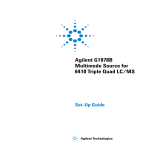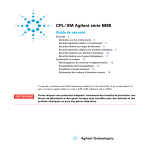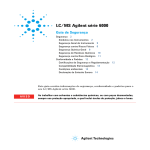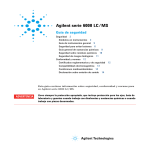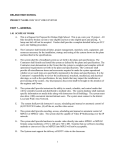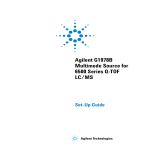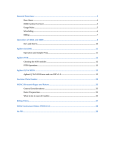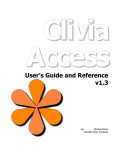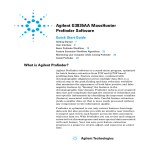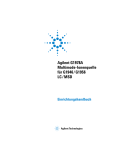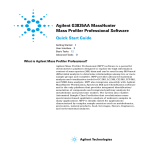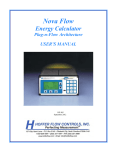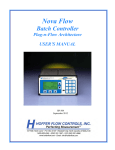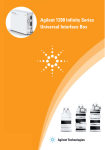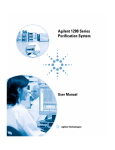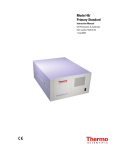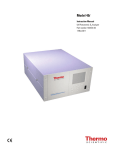Download Agilent 6400 Series Triple Quad LC/MS System
Transcript
Agilent 6400 Series Triple Quad LC/MS System Installation Guide Agilent Technologies Notices © Agilent Technologies, Inc. 2006-2010 Warranty No part of this manual may be reproduced in any form or by any means (including electronic storage and retrieval or translation into a foreign language) without prior agreement and written consent from Agilent Technologies, Inc. as governed by United States and international copyright laws. The material contained in this document is provided “as is,” and is subject to being changed, without notice, in future editions. Further, to the maximum extent permitted by applicable law, Agilent disclaims all warranties, either express or implied, with regard to this manual and any information contained herein, including but not limited to the implied warranties of merchantability and fitness for a particular purpose. Agilent shall not be liable for errors or for incidental or consequential damages in connection with the furnishing, use, or performance of this document or of any information contained herein. Should Agilent and the user have a separate written agreement with warranty terms covering the material in this document that conflict with these terms, the warranty terms in the separate agreement shall control. Manual Part Number G3335-90081 Edition Tenth Edition, May 2010 Printed in USA Agilent Technologies, Inc. 5301 Stevens Creek Blvd. Santa Clara, CA 95051 Windows ® and Microsoft ® is a U.S. registered trademark of Microsoft Corporation. Windows NT ® is a U.S registered trademark of Microsoft Corporation. Software Revision This guide is valid for the B.03.01 revision or higher of the Agilent MassHunter Workstation Software - Data Acquisition program and compatible Qualitative Analysis and Quantitative Analysis programs, until superseded. Safety Notices Technology Licenses The hardware and/or software described in this document are furnished under a license and may be used or copied only in accordance with the terms of such license. Restricted Rights Legend U.S. Government Restricted Rights. Software and technical data rights granted to the federal government include only those rights customarily provided to end user customers. Agilent provides this customary commercial license in Software and technical data pursuant to FAR 12.211 (Technical Data) and 12.212 (Computer Software) and, for the Department of Defense, DFARS 252.227-7015 (Technical Data - Commercial Items) and DFARS 227.7202-3 (Rights in Commercial Computer Software or Computer Software Documentation). CAUTION A CAUTION notice denotes a hazard. It calls attention to an operating procedure, practice, or the like that, if not correctly performed or adhered to, could result in damage to the product or loss of important data. Do not proceed beyond a CAUTION notice until the indicated conditions are fully understood and met. WA R N I N G A WARNING notice denotes a hazard. It calls attention to an operating procedure, practice, or the like that, if not correctly performed or adhered to, could result in personal injury or death. Do not proceed beyond a WARNING notice until the indicated conditions are fully understood and met. Agilent 6400 Series Triple Quad LC/MS System In This Guide… This guide contains information to install the Agilent 6400 Series Triple Quad LC/MS System. 1 Instrument Installation This chapter describes the steps that are needed to install the Triple Quad instrument. 2 Software Installation and Configuration This chapter describes the steps that are needed to install the MassHunter software. 3 Installation Completion and System Verification In this chapter, you finish the hardware setup. 4 Installation and Verification of Other Sources This chapter contains the steps needed to install and verify the operation of the APCI and APPI sources. 5 Other Setup Tasks This chapter contains tasks that are related to setting up your Triple Quad instrument. 6 Reference This chapter contains parameters for verifying performance. Agilent 6400 Series Triple Quad LC/MS System Installation Guide 3 4 Agilent 6400 Series Triple Quad LC/MS System Content 1 Instrument Installation 7 Step 1. Unpack and set up the Triple Quad instrument 8 Step 2. Prepare to install the system 9 Step 3. Set up the rough pump 13 Step 4. Connect the Triple Quad instrument 16 Step 5. Install the source 23 Step 6. Install the Agilent 1100 or 1200 series LC system 29 2 Software Installation and Configuration 31 Step 1. Set up the computer system 32 Step 2. Check PC network card configuration 33 Step 3. Prepare for installation 35 Step 4. Install the Data Acquisition program 36 Step 5. Install the Qualitative Analysis program 41 Step 6. Install the Quantitative Analysis program 43 Step 7. Install and configure Microsoft Excel 2007 47 Step 8. Install Service Packs for Data Acquisition 51 Step 9. Install Quantitative Analysis Reporting 52 Step 10. Check Excel Add-Ins for MassHunter 54 Step 11. Configure the instrument 55 Step 12. Copy the support folder to the computer 56 Step 13. Confirm the LC firmware revision 58 Step 14. Finish the installation 59 3 Installation Completion and System Verification 61 Step 1. Condition the 1100 / 1200 LC 62 Step 2. Prepare the performance evaluation samples Step 3. Review methods and run worklist 66 Step 4. Verify the Triple Quad sensitivity 73 To reset the Collision Cell gas flow rate 77 Agilent 6400 Series Triple Quad LC/MS System Installation Guide 64 5 Contents 4 Installation and Verification of Other Sources 81 G1947B APCI Source 82 To install the G1947B APCI source 82 To verify the operation of the G1947B APCI source 83 G1978B Multimode Source 84 To install the G1978B multimode source 84 To verify the operation of the G1978B multimode source G1971B APPI Source 86 To install the G1971B APPI source 86 To verify the operation of the G1971B APPI source HPLC-Chip/MS Cube Interface 88 Step 1. Prepare performance verification sample Step 2. Prepare the HPLC-Chip/MS 90 Step 3. Analyze the results 93 5 Other Setup Tasks 85 87 88 97 To start the Data Acquisition program 98 To stop MassHunter Engines 98 To stop MassHunter processes in case of unrecoverable errors To view the log book 98 To configure the network interface card 99 To confirm configuration of NICs 100 To remove the MassHunter Workstation software 102 To reconfigure the instrument 103 6 Reference 105 6460/6430 Reserpine Checkout Method Acquisition Parameters 6 98 106 Agilent 6400 Series Triple Quad LC/MS System Installation Guide Agilent 6400 Series Triple Quad LC/MS System Installation Guide 1 Instrument Installation Step 1. Unpack and set up the Triple Quad instrument 8 Step 2. Prepare to install the system 9 Step 3. Set up the rough pump 13 Step 4. Connect the Triple Quad instrument 16 Step 5. Install the source 23 Step 6. Install the Agilent 1100 or 1200 series LC system 29 This chapter describes the steps that are needed to install the Triple Quad instrument. Figure 1 6460 Triple Quad LC/MS Agilent Technologies 7 1 Instrument Installation Step 1. Unpack and set up the Triple Quad instrument Step 1. Unpack and set up the Triple Quad instrument NOTE Do not open the shipping containers until an Agilent representative is present to verify the contents of each carton. Warranty claims for missing items are honored only if an Agilent representative is on site to verify the contents of each shipping container as it is unpacked. Checkout and tuning samples are shipped separately to comply with safety regulations and to ensure prompt delivery. Make sure that these samples have been stored correctly, as indicated in the instructions in the box. 1 Carefully examine all containers for external signs of damage. If damage is discovered, immediately contact the carrier and the Agilent Service Management. Retain shipping containers and material until contents are checked for completeness and instrument performance is verified. 2 Check off each item on the packing list, and verify the serial numbers. 3 Record the serial numbers in the installation documentation. 4 Report any discrepancies to Agilent Technologies. 5 Check that site preparation is complete, which includes power and gas supplies and chemical supplies needed for installation and performance verification. 6 Check the line voltage. Verify the proper line voltage and outlet ratings according to the instructions given in the Site Preparation Guide. 8 Agilent 6400 Series Triple Quad LC/MS System Installation Guide Instrument Installation Step 2. Prepare to install the system 1 Step 2. Prepare to install the system Before you begin, check that you have these parts: • Utility knife and needle nose pliers 1 Unpack and set up the Triple Quad instrument. a Cut the tie wraps around the package. See Figure 2. Figure 2 Triple Quad instrument shipping container b Lift the boxes off the top of the instrument. See Figure 3. Agilent 6400 Series Triple Quad LC/MS System Installation Guide 9 1 Instrument Installation Step 2. Prepare to install the system Figure 3 Instrument unboxed on shipping pallet (6460 pictured) c Remove the front, top, right, back- left, and lower front- left cosmetic covers so that you can remove the shipping brackets. You do not need to remove the upper front- left cover. To remove the top cover, remove the two screws at the back side of the top cover that secure the back of the top cover to the instrument chassis (see Figure 4). These screws are only needed when shipping the instrument. You do not need to reinstall the screws when you reinstall the top cover. 10 Agilent 6400 Series Triple Quad LC/MS System Installation Guide Instrument Installation Step 2. Prepare to install the system 1 Figure 4 Remove shipping screws from back of top panel. The screws to remove are circled in this picture. d Remove the shipping brackets (a total of 7). You will need to use a 13- mm wrench. Figure 5 Triple Quad on shipping pallet with covers removed (6460 pictured) Agilent 6400 Series Triple Quad LC/MS System Installation Guide 11 1 Instrument Installation Step 2. Prepare to install the system e Take an inventory of the contents of the packages. f Record serial numbers. The serial number label for the Triple Quad instrument is located on the lower left corner to the left of the instrument power push button. 2 Use four people, one at each corner of the instrument, to lift the Triple Quad instrument onto a stable bench or table. NOTE Do NOT lift from under the power switch bracket on the front left corner of the instrument. The bracket will bend. See Figure 6. Figure 6 WA R N I N G 12 Do not lift from under power switch bracket Do not lift the Triple Quad without assistance. The instrument weighs up to 115 kg (255 lbs). Lift with your knees, not with your back. Keep your back straight while you bend your knees. Agilent 6400 Series Triple Quad LC/MS System Installation Guide Instrument Installation Step 3. Set up the rough pump 1 Step 3. Set up the rough pump 1 Unpack the mist filter, exhaust hose, and pump oil drip pan from the shipping kit. 2 Remove the rough pump from its shipping container: a Cut the straps that secure the cardboard box to the wooden pallet. b Lift off the cardboard box. c Set aside the two bottles of pump oil and funnel. d Set aside the oil return kit. The felt plugs and screen inside the packaging are not needed and may be discarded. e Use a pair of needle nose pliers to remove the metal clips that secure the pump to the wooden pallet. 3 Set the pump into the pump oil drip pan. The pan is used to catch any small amounts of oil that may seep out of the pump. The pan can also contain all of the oil in the pump in case of a catastrophic seal failure. 4 Fill the rough pump with Inland 45 fluid. The rough pump is drained of vacuum pump oil prior to shipment. Remove the oil fill cap and use the funnel to add Inland 45 pump fluid until the level in the site glass is approximately 2/3 full. 5 Install the oil mist filter. Remove the plugged outlet connector and install the new KF- 25 fitting that comes with the pump. Do not use the outlet nozzle as described in the Edwards manual and on the warning tag. Install the mist filter on the outlet port KF- 25 fitting. See figure on the next page. Make sure the mist filter drain plug is facing the rough pump ballast valve (toward the motor end of the pump). 6 Install the oil return line: a Remove the drain plug from the mist filter and install the drain adapter. b Install the brass restrictor into the black oil- return tubing. c Connect the oil- return tubing between the rough pump ballast port fitting and the oil mist filter drain adapter. Make sure the end of the tubing with the brass restrictor is installed at the ballast port fitting. Agilent 6400 Series Triple Quad LC/MS System Installation Guide 13 1 Instrument Installation Step 3. Set up the rough pump d Use the plastic hose clips and a pair of needle nose pliers to secure the oil- return tubing. Rough pump hose Exhaust hose Oil mist filter Ballast valve Oil return line Oil level sight glass Oil drain plug Oil drip pan Figure 7 Example rough pump. Note that your pump may look slightly different. 7 Check that the ballast valve is closed. Closing the ballast valve prevents additional air from being introduced to the pump. This allows the rough pump to reach a lower operating pressure. CAUTION 14 The ballast valve must be opened (fully counterclockwise) periodically to allow oil trapped in the mist filter to return to the pump. If the oil is not returned to the pump, the pump will eventually run dry and be damaged. Agilent 6400 Series Triple Quad LC/MS System Installation Guide Instrument Installation Step 3. Set up the rough pump 1 8 Find the Low Profile Exhaust Adaptor (p/n G1960- 20003) and the O- ring (p/n 0905- 1592). Put the O- ring on the exhaust adaptor. 9 Locate one KF- 25 swing clamp (p/n 0100- 1398), open the swing clamp, and use it to clamp the exhaust adaptor onto the oil mist filter. Connect the 1/2- inch I.D. Tygon exhaust tubing to the exhaust adaptor. Agilent 6400 Series Triple Quad LC/MS System Installation Guide 15 1 Instrument Installation Step 4. Connect the Triple Quad instrument Step 4. Connect the Triple Quad instrument 1 Connect the rough hose (p/n G1969- 20123) that is supplied in the ship kit to the KF- 25 rough pump hose connection on the back left of the instrument. 2 Connect the rough pump hose to the KF- 25 inlet adapter on the rough pump. 3 Use the supplied hook/loop fastener tape to secure the drain bottle into a secondary containment tub. 4 Connect the spray chamber drain tube to the 1- inch fitting on the drain bottle. The drain tube can also be routed out the front of the Triple Quad if needed. 5 Attach the calibrant delivery system (CDS)/inlet module waste tubing from the solvent selection valve on the Triple Quad to the ¼- inch fitting on the drain bottle. 6 Connect a length of the ½- inch Tygon tubing to the ½- inch fitting on the drain bottle, then connect the other end of the tubing to a vent connection that is separate from the vent used for the rough pump. CAUTION 16 The drain bottle vent must be located away from the rough pump vent to prevent the rough pump exhaust from contaminating the Triple Quad spray chamber. Agilent 6400 Series Triple Quad LC/MS System Installation Guide Instrument Installation Step 4. Connect the Triple Quad instrument 1 Spray chamber drain tube Drain bottle vent CDS inlet and LC waste fitting Waste drain bottle Secondary containment (customer supplied) Figure 8 Drain bottle Agilent 6400 Series Triple Quad LC/MS System Installation Guide 17 1 Instrument Installation Step 4. Connect the Triple Quad instrument 7 Install the gas filter: For 6410/6430: a Connect an appropriate length of the 1/4- inch teflon gas tubing (G1946- 80078) to nitrogen gas source. Use the supplied nut and ferrule kit (p/n 5183- 0392). Keep some tubing for step c and step d. b Attach the other end of the of the tubing (from the nitrogen gas source) to the BHT- 4 gas filter. Use the nuts and ferrules supplied with the BHT- 4 gas filter. Outlet to LC/MS BHT-4 c Use a piece of 1/4- inch teflon gas tubing to connect the BMT- 4 gas filter to the BHT- 4 gas filter. Use the nuts and ferrules supplied with the BMT- 4 and BHT- 4 gas filters. d Connect a new length of 1/4- inch teflon gas tubing to the other end of the BHT- 4 gas filter. Use the other nut and ferrule kit supplied with the BHT- 4 gas filter. BMT-4 e Connect the gas tubing from the BHT- 4 gas filter (from step d) to the nitrogen gas fitting on the back of the LC/MS system. Use the supplied nut and ferrule kit (p/n 5183- 0392). f Secure the gas filter in a vertical position with tie wraps. This configures the filters in series with the supply tubing. See Figure 9 as an example for assembling the gas trap in the correct configuration. 18 Inlet from nitrogen gas source Figure 9 Gas filter connected in series Agilent 6400 Series Triple Quad LC/MS System Installation Guide Instrument Installation Step 4. Connect the Triple Quad instrument 1 For 6460: a Locate the 2 1/4- inch brass T- unions (0100- 0088) and loosen the brass nuts on the T- unions. b Use an appropriate length of the 1/4- inch teflon gas tubing (G1946- 80078) to connect the nitrogen gas source to the center connector of one T- union. Outlet to LC/MS BHT-4 c Connect two 10- cm lengths of 1/4- inch teflon gas tubing to each side of the T- union. Use the nuts and ferrules supplied with the T- union. d Attach the other end of the 10- cm lengths of 1/4- inch teflon gas tubings (from step c) to the two BMT- 4 gas filters. Use the nuts and ferrules supplied with the BMT- 4 gas filters. e Use a small length of gas tubings to connect each BMT- 4 gas filter to a BHT- 4 gas filter. Use the nuts and ferrules from the BMT- 4 and BHT- 4 gas filters. f Attach the other end of each BHT- 4 gas filter to a 10- cm length of 1/4- inc teflon gas tubing. Use the nuts and ferrules supplied with the BHT- 4 gas filters. BMT-4 Inlet from nitrogen gas source Figure 10 Gas filter, connected first in series, then in parallel. g Connect the other end of each 10- cm length of gas tubing (from step f) to the ends of the remaining T- union. Use the nuts and ferrules supplied with the T- union. h Connect the gas tubing from the BHT- 4 gas filter (from step g) to the nitrogen gas fitting on the back of the LC/MS system. Use the supplied nut and ferrule kit (p/n 5183- 0393). i Secure the gas filter in a vertical position with tie wraps. Agilent 6400 Series Triple Quad LC/MS System Installation Guide 19 1 Instrument Installation Step 4. Connect the Triple Quad instrument 1/8-inch nitrogen gas connection for collision gas supply Do not use! 1/4-inch nitrogen gas connection for drying gas supply Figure 11 Power and gas connections on back left of Triple Quad 8 Set the pressure on the nitrogen supply regulator at 80 to 100 psi (550 to 690 kPa). Turn on the nitrogen gas for a few minutes to purge the tubing and gas conditioner before you connect the nitrogen gas supply to the Triple Quad. Regulator pressures above 110 psi (760 kPa) cause nitrogen waste due to release from the bleed valve on the flow- control module. 9 Use the tubing cutters (p/n 8710- 1709) supplied in the ship kit to cut an appropriate length of the 1/8- inch copper supply tubing (p/n 5180- 4196) to connect from the outlet fitting on the collision cell nitrogen tank regulator to the nitrogen gas conditioner (p/n RMSN- 2) for the collision cell gas, then cut a second length of the 1/8 - inch copper supply tubing to connect from the nitrogen gas conditioner to 20 Agilent 6400 Series Triple Quad LC/MS System Installation Guide Instrument Installation Step 4. Connect the Triple Quad instrument 1 the collision cell gas inlet fitting on the left side of the Triple Quad (see Figure 11). Secure the gas filters in a vertical position with tie wraps. Remote start connection LAN connection from HUB/switch Rough pump power cord connection AC line power connection Figure 12 Power and electrical connection at back left side of Triple Quad 10 Set the pressure on the Collision Cell supply regulator at 10 to 30 psi (70 to 210 kPa). Agilent 6400 Series Triple Quad LC/MS System Installation Guide 21 1 Instrument Installation Step 4. Connect the Triple Quad instrument CAUTION Do not attach the Collision Cell gas fitting to the nitrogen supply regulator at 80 to 100 psi (550 to 690 kPa). The Collision Cell Gas Flow Module should not receive a supply greater than 30 psi (210 kPa). The Collision Cell can use the same nitrogen supply as the regular supply (i.e. for drying gas, nebulizer, CDS pressure) if it is the required purity (99.999%) but it must be down-regulated to 30 psi (210 kPa). 11 Connect the remote start cable to its connector on the back left side of the Triple Quad. See Figure 12. 12 Connect the rough pump power cord into the rough pump connector on the back left side of the Triple Quad (see Figure 12). 13 Verify the front power switch is in the OFF position. 14 Plug the Triple Quad power cord into the Triple Quad power connector on the Triple Quad and the other end of the Triple Quad power cord into the wall outlet. See Figure 12. 22 Agilent 6400 Series Triple Quad LC/MS System Installation Guide Instrument Installation Step 5. Install the source 1 Step 5. Install the source You can use an electrospray, the multimode source or the HPLC- Chip for 6410 check out. ESI with Agilent Jet Stream Technology (6460 only) Before you begin, check that you have these parts: • Electrospray with Agilent Jet Stream Technology • ESI- L Low Concentration Tuning Mix (p/n G1969- 85000) 1 Remove the top cover by loosening the T10 lock screw and lifting off the instrument chassis. 2 Remove the electrospray interface with Agilent Jet Stream Technology from the packaging inside the instrument chassis next to the e- Module. See Figure 13. Figure 13 Packaging for ESI with Agilent Jet Stream Technology 3 Remove the foil that covers the spray chamber mount, and remove the shipping cover from the Electrospray spray chamber. Agilent 6400 Series Triple Quad LC/MS System Installation Guide 23 1 Instrument Installation Step 5. Install the source 4 Put the nebulizer in the nebulizer adjustment fixture supplied in the shipping kit and check that the nebulizer needle is properly adjusted. The nebulizer needle should be even with the end of the nebulizer nozzle. 5 Install the nebulizer in the spray chamber. 6 Install the spray chamber on the spray chamber mount, close the spray chamber, and fasten the latch. You may need to adjust the latch to ensure that the O- ring seals completely. Use a ¼- inch x 5/16- inch wrench to loosen the lock nut, then adjust the latch to the proper fit, then tighten the lock nut so that the latch maintains its adjustment. 7 Connect the high voltage and vaporizer cables to the connectors on the left side panel of the instrument. 8 Connect the 1/8- inch nebulizing gas tubing from the Triple Quad mainframe to the nebulizer gas fitting. 9 Connect the 1/8- inch sheath gas tubing from the Triple Quad mainframe to the sheath gas fitting on the ESI with Agilent Jet Stream Technology. 10 Connect the PEEK tubing from the selection valve (inside the front cover) to the top of the nebulizer. 24 Agilent 6400 Series Triple Quad LC/MS System Installation Guide Instrument Installation Step 5. Install the source 1 High voltage connection Vaporizer port Nebulizer gas Sheath gas Figure 14 Connections for ESI with Agilent Jet Stream Technology 11 Rinse the calibrant bottle three times with hot (60°C) water and then three times with methanol. Then rinse it once with acetonitrile. 12 Add the ESI- L Low Concentration Tuning Mix to the calibrant bottle. CAUTION Never use aliphatic, aromatic or halogenated hydrocarbons in the CDS. These solvents are not compatible with the O-ring in the CDS. 13 Turn on the Triple Quad front power switch to start the pump- down of the Triple Quad. The rough pump will become quieter within a few seconds. Agilent 6400 Series Triple Quad LC/MS System Installation Guide 25 1 Instrument Installation Step 5. Install the source Agilent G1948B Electrospray Before you begin, check that you have these parts: • Agilent G1948B Electrospray interface (the G1948A Electrospray interface is not supported) • Nebulizer spacer kit (p/n G1946- 60254) • ESI- L Low Concentration Tuning Mix (p/n G1969- 85000) 1 Remove the foil that covers the spray chamber mount, and remove the shipping cover from the Electrospray spray chamber. 2 Install the nebulizer spacer as follows: a Use a flat- bladed screwdriver to remove the two nebulizer shoulder screws from the top of the spray chamber. b Use the two m3x8 Torx T10 screws to install the nebulizer spacer onto the top of the spray chamber. c Install the two nebulizer shoulder screws into the top of the nebulizer spacer. 3 Put the nebulizer in the nebulizer adjustment fixture supplied in the shipping kit and check that the nebulizer needle is properly adjusted. The nebulizer needle should be even with the end of the nebulizer nozzle. 4 Install the nebulizer in the spray chamber. 5 Install the spray chamber on the spray chamber mount, close the spray chamber, and fasten the latch. You may need to adjust the latch to ensure that the O- ring seals completely. Use a ¼- inch x 5/16- inch wrench to loosen the lock nut, then adjust the latch to the proper fit, then tighten the lock nut so that the latch maintains its adjustment. 6 Connect the 1/8- inch nebulizing gas tubing from the Triple Quad mainframe to the nebulizer gas fitting. 7 Connect the PEEK tubing from the selection valve (inside the front cover) to the top of the nebulizer. 8 Rinse the calibrant bottle three times with hot (60°C) water and then three times with methanol. Then rinse it once with acetonitrile. 9 Add the Electrospray calibrant to the calibrant bottle. 26 Agilent 6400 Series Triple Quad LC/MS System Installation Guide Instrument Installation Step 5. Install the source CAUTION 1 Never use aliphatic, aromatic or halogenated hydrocarbons in the CDS. These solvents are not compatible with the O-ring in the CDS. 10 Turn on the Triple Quad front power switch to start the pump- down of the Triple Quad. The rough pump will become quieter within a few seconds. G1978B Multimode Source 1 Install these parts from the Multimode and APCI enablement kits that ship with the G1978B Multimode source into the Aux module on the Triple Quad LC/MS: • APCI High Voltage Power Supply (p/n G1946- 80058) • Multimode HV board (p/n G1960- 61015) • Valve board—APCI HV PS cable (p/n G1960- 60802) • Valve board—APCI Needle Interlock cable (p/n G1960- 60856) • Multimode HV board cable (p/n G1960- 60858) • Multimode Power Data cable (p/n G1960- 60878) • MMI- L Low Concentration Tuning Mix (p/n G1969- 85020) 2 Connect the multimode and corona needle cables to the respective connectors on the left side panel of the Triple Quad LC/MS. 3 Put the nebulizer in the nebulizer adjustment fixture supplied in the shipping kit and check that the nebulizer needle is properly adjusted. The nebulizer needle should be even with the end of the nebulizer nozzle. 4 Install the nebulizer in the spray chamber. 5 Install the spray chamber on the spray chamber mount, close the spray chamber, and fasten the latch. You may need to adjust the latch to ensure that the O- ring seals completely. Use a ¼- inch x 5/16- inch wrench to loosen the lock nut, then adjust the latch to the proper fit, then tighten the lock nut so that the latch maintains its adjustment. 6 Connect the 1/8- inch nebulizing gas tubing from the Triple Quad mainframe to the nebulizer gas fitting. Agilent 6400 Series Triple Quad LC/MS System Installation Guide 27 1 Instrument Installation Step 5. Install the source 7 Connect the PEEK tubing from the selection valve (inside the front cover) to the top of the nebulizer. 8 Rinse the calibrant bottle three times with hot (60°C) water and then three times with methanol. Then rinse it once with acetonitrile. 9 Add the Multimode calibrant to the calibrant bottle. CAUTION Never use aliphatic, aromatic or halogenated hydrocarbons in the CDS. These solvents are not compatible with the O-ring in the CDS. 10 Turn on the Triple Quad front power switch to start the pump- down of the Triple Quad. The rough pump will become quieter within a few seconds. 28 Agilent 6400 Series Triple Quad LC/MS System Installation Guide Instrument Installation Step 6. Install the Agilent 1100 or 1200 series LC system 1 Step 6. Install the Agilent 1100 or 1200 series LC system Before you begin, check that you have these parts: • HPLC grade methanol, or better • HPLC grade water, or better 1 Install the Agilent 1100 or 1200 LC system. Follow its installation documents. Other LCs are not supported. 2 Connect the remote start cable from the Triple Quad to a Remote Start connector on the LC sampler, pump or other detector module only. 3 Install an Agilent G1369A LAN Interface card into the LC detector module. If a detector module is not present, install the Agilent G1369A LAN Interface card into the pump module. Before you install the LAN Interface card, set switches 5 and 6 to the ON position. This will force the Agilent LAN Interface Card to use its default IP address and subnet mask. NOTE Note: For a G1315C/D DAD SL, the LAN interface is built into the module main board. To set the G1315C/D to the proper IP address, set switch positions 7 and 8 to the ON or UP position. By default, switch positions 7 and 8 are in the down position. Refer to the Agilent 1200 Series Diode Array and Multiple Wavelength Detector User Manual (part number G1315-90012) for more information. The default IP address is 192.168.254.11 and the default subnet mask is 255.255.255.0. Agilent 6400 Series Triple Quad LC/MS System Installation Guide 29 1 Instrument Installation Step 6. Install the Agilent 1100 or 1200 series LC system CAUTION 30 Do not use any other LAN interface card besides the G1369A (e.g. the older Jet Direct card J4100A). Agilent 6400 Series Triple Quad LC/MS System Installation Guide Agilent 6400 Series Triple Quad LC/MS System Installation Guide 2 Software Installation and Configuration Step 1. Set up the computer system 32 Step 2. Check PC network card configuration 33 Step 3. Prepare for installation 35 Step 4. Install the Data Acquisition program 36 Step 5. Install the Qualitative Analysis program 41 Step 6. Install the Quantitative Analysis program 43 Step 7. Install and configure Microsoft Excel 2007 47 Step 8. Install Service Packs for Data Acquisition 51 Step 9. Install Quantitative Analysis Reporting 52 Step 10. Check Excel Add-Ins for MassHunter 54 Step 11. Configure the instrument 55 Step 12. Copy the support folder to the computer 56 Step 13. Confirm the LC firmware revision 58 Step 14. Finish the installation 59 If you purchased a bundled Triple Quad instrument system, the MassHunter Workstation software has been installed for you. In this case, skip to “Step 7. Install and configure Microsoft Excel 2007” and complete the steps that remain. Agilent Technologies 31 2 Software Installation and Configuration Step 1. Set up the computer system Step 1. Set up the computer system 1 Set up the PC: a Verify that the line voltage is correct. b Unpack the PC and put it on a suitable benchtop or table. c Connect the keyboard, mouse, monitor and printer to the computer. 2 Verify that two network cards are available in the PC. One of these is usually a “built- in” card, and the second is located in an accessory slot. Follow the installation documentation supplied with the PC to install and verify components as needed. 3 Install the network hub: a Put the hub on the table next to the PC. b Plug the power supply into the hub. c Connect the power supply to a power outlet. 4 Connect one end of a Category 5, shielded twisted pair (STP) cable to any port (1 to 7) on the network hub. Connect the other end of the cable to the 10/100 Base- T network card in slot 1 of the PC. The card should be labeled LC/MS. Do not connect to port 8 on the hub/switch. 5 Connect a second Category 5 STP LAN cable from one of the open ports 1 to 7 on the hub to the Agilent LAN Card in the 1100 or 1200 pump or detector. 6 Connect a third Category 5 STP LAN cable from one of the open ports 1 to 8 on the hub to the LAN interface connection on the LAN/MS control card in the Triple Quad instrument. 7 Install the printer. See the installation documentation supplied with the printer. 8 Turn on the printer, hub, monitor, and PC, in that order. The computer comes loaded with software and the appropriate drivers for the installed accessories. The initial Administrator password is provided on a sticker on the PC. 32 Agilent 6400 Series Triple Quad LC/MS System Installation Guide Software Installation and Configuration Step 2. Check PC network card configuration 2 Step 2. Check PC network card configuration 1 Click Start > Control Panel > Network Connections. 2 From the list of network connections, right- click the network connection that corresponds to the instrument LAN connection, then click Properties. 3 Scroll down the list to Internet IP Protocol, click it, then click Properties. Figure 15 Local Area Connection Properties dialog box - General tab Agilent 6400 Series Triple Quad LC/MS System Installation Guide 33 2 Software Installation and Configuration Step 2. Check PC network card configuration 4 Make sure the Network Adapter is set to these settings: IP address: 192.168.254.1 Subnet mask: 255.255.255.0 Figure 16 34 Internet Protocol (TCP/IP) Properties dialog box Agilent 6400 Series Triple Quad LC/MS System Installation Guide Software Installation and Configuration Step 3. Prepare for installation 2 Step 3. Prepare for installation 1 If this installation is an upgrade, use the Add or Remove Programs command in Control Panel to remove programs that you will be upgrading, if they are installed on your system. Do not remove programs for which you need only to install a service pack. • Excel 2003 • Agilent MassHunter Workstation Qualitative Analysis • Agilent MassHunter Workstation Quantitative Analysis • Agilent MassHunter Workstation Quantitative Analysis Reporting • Agilent MassHunter Workstation Optimizer NOTE Remove only the programs that you plan to upgrade at this time. Do not remove the Agilent MassHunter Workstation Data Acquisition program at this time. 2 Optional. Back up the data, method and worklist files in the D:\MassHunter folder. Use the back- up method of your choice. The uninstallation program keeps your data, method and worklist files. It also backs up your tuning and hardware setting files, which are restored during installation. Do not move, remove or rename the D:\MassHunter folder, or your tuning and hardware settings will not be saved. 3 Run Windows Update to make sure you have the latest critical updates and security fixes. Make sure Windows Update is completed before you continue. CAUTION If you do not run Windows Update, your system may be vulnerable to security problems. Confirm that the LAN power management has not been reactivated by a Windows Update program. Agilent 6400 Series Triple Quad LC/MS System Installation Guide 35 2 Software Installation and Configuration Step 4. Install the Data Acquisition program Step 4. Install the Data Acquisition program The Data Acquisition program is pre- installed on the shipping PC when ordered together with the instrument as a bundle. If the program is already installed, continue at “Step 7. Install and configure Microsoft Excel 2007” on page 47. If this is an upgrade from the same revision, such as from B.03.01 to B.03.01 SP1, continue at “Step 5. Install the Qualitative Analysis program” on page 41. 1 Check that no other program is running on your system, including Windows Update. 2 Put the Data Acquisition installation disk into the disk drive. The welcome screen appears. See Figure 17. Figure 17 Installation Welcome Screen 3 If this is an upgrade installation, click Uninstall MassHunter Data Acquisition Software, then follow the instructions on the screen to remove the current program. 36 Agilent 6400 Series Triple Quad LC/MS System Installation Guide Software Installation and Configuration Step 4. Install the Data Acquisition program 2 4 Click Install MassHunter Data Acquisition Software, then follow the instructions on the screen to install the software. • In the License Agreement screen, click I accept the terms of the license agreement, then click Next. • In the Choose Destination Location screen, click Next to accept the default destination location. The default is C:\Program Files\Agilent\MassHunter\Workstation\Acq. • In the Choose location for customer data files screen, check that the default of D:\MassHunter is displayed in the text box, then click Next. See Figure 18. Figure 18 Choose location for customer data files screen • In the Start Copying Files screen, review the settings then click Next. The Setup Status screen now appears. • If you get a message that indicates that the screen resolution is not set to the required 1280 x 1024 resolution, click OK. The best resolution for MassHunter is either 1600 x 1200 (for 4 x 3 aspect ratio) or 1920 x 1080 (for 16 x 9). Agilent 6400 Series Triple Quad LC/MS System Installation Guide 37 2 Software Installation and Configuration Step 4. Install the Data Acquisition program • If you see a Notepad window that prompts you to install other options, close the Notepad window. • When the InstallShield Wizard Complete message is displayed, click Finish. 5 Click Upgrade MS Firmware. 6 Type the IP address of the Triple Quad instrument (192.168.254.12) and press Enter. 7 When prompted, type Y for yes to proceed with update. 38 Agilent 6400 Series Triple Quad LC/MS System Installation Guide Software Installation and Configuration Step 4. Install the Data Acquisition program 2 8 If the instrument is using an ESI with Agilent Jet Stream Technology: a When prompted, enter the country- specific nominal input voltage. Verify with a Digital Multi- Meter (DM) using the AC Voltage measuring function. For example, in the United States, the closest nominal voltage for the Triple Quad instrument is 208V so you would select option 3. CAUTION The ESI with Agilent Jet Stream Technology uses 95% input voltage duty cycle to heat properly. Improper settings can severely hamper its performance. Agilent 6400 Series Triple Quad LC/MS System Installation Guide 39 2 Software Installation and Configuration Step 4. Install the Data Acquisition program b When prompted, confirm input voltage set in the previous step. c Reboot the LC/MS interface card, or turn on and off the instrument, when prompted. Once the firmware update has completed, you will be prompted to close the DOS window. 9 Optional. Click Install MassHunter Data Acquisition Manuals to copy the user guides to the location of your choice. The installation program automatically copies the MassHunter user guides onto your computer so that they can be opened from online Help. The user guides are also available on the installation disk in the Manuals folder. Click this button only if you want an additional set of user guides copied to the location of your choice. 40 Agilent 6400 Series Triple Quad LC/MS System Installation Guide Software Installation and Configuration Step 5. Install the Qualitative Analysis program 2 Step 5. Install the Qualitative Analysis program The Qualitative Analysis and Quantitative Analysis programs are pre- installed on the shipping PC when ordered together with the instrument as a bundle. If the programs are already installed, continue with “Step 7. Install and configure Microsoft Excel 2007” on page 47. 1 Check that no other program is running on your system, including Windows Update. Installation of the Qualitative Analysis program will fail if Windows Update is running, even in the background. 2 Install the Qualitative Analysis program: a Put the Qualitative Analysis installation DVD into the DVD drive. b If you are installing only the service pack for the Qualitative Analysis program, continue at step 4. c From the installation disk, double- click Setup.exe. d In the License Agreement screen, click I accept the terms of the license agreement, then click Next. e In the Choose Destination Location screen, click Next to accept the default destination location. The default is C:\Program Files\Agilent\MassHunter\Workstation\Qual. f In the Choose location for customer data files screen, check that the default of D:\MassHunter is displayed in the text box, then click Next. See Figure 19. Agilent 6400 Series Triple Quad LC/MS System Installation Guide 41 2 Software Installation and Configuration Step 5. Install the Qualitative Analysis program Figure 19 Location for data files g In the Start Copying Files screen, review the settings then click Next. h If you get a message that indicates that the screen resolution is not set to the required 1280 x 1024 resolution, click OK. The best resolution for MassHunter is either 1600 x 1200 (for 4 x 3 aspect ratio) or 1920 x 1080 (for 16 x 9). i If you see a Notepad window that prompts you to install other options, close the Notepad window. 3 When the InstallShield Wizard Complete message is displayed, click Finish. 4 From within a Windows file manager window, check the installation disk for any folder that includes the word Service Packs. 5 If one or more service pack files or folders exist on the installation disk, then for each service pack file: a Double- click the name of the most recent service pack to run the installation program. You may need to open folders inside the service pack folder to find the installation file. The name of service pack installation files typically end in SP x.exe. b Follow the instructions to install the service pack. 42 Agilent 6400 Series Triple Quad LC/MS System Installation Guide Software Installation and Configuration Step 6. Install the Quantitative Analysis program 2 Step 6. Install the Quantitative Analysis program 1 Check that no other program is running on your system. Installation of the Quantitative Analysis program will fail if Windows Update is running, even in the background. 2 Install the Quantitative Analysis program: a Put the Quantitative Analysis installation disk into the disk drive. b If you are installing only the service pack for the Quantitative Analysis program, continue at step 5. c From the root directory of the installation disk, double- click setup_quant.exe. d When prompted, select the language for the installation. e In the Welcome to the InstallShield Wizard window, click Next to continue with the installation. f In the License Agreement window, click I accept the terms in the license agreement, then click Next. g In the Destination Folder window, click Next to accept the default destination location. The default is C:\Program Files\Agilent\MassHunter\Workstation\Quant. h In the Customer Data Folder window, click the Change button and select the path used to store data files, click the OK button, then click Next. This data file location is typically the path used by the MassHunter Data Acquisition Workstation to store acquired data. Agilent 6400 Series Triple Quad LC/MS System Installation Guide 43 2 Software Installation and Configuration Step 6. Install the Quantitative Analysis program i When the Choose Desktop Icons window appears, mark the check boxes for the instruments that apply. Clear the check boxes for the instruments that do not apply. Click Next (Figure 20). Figure 20 Choose desktop icons window j When the Ready to Install the Program window appears, click Install to begin. When the installation begins, you will see the Installing Agilent MassHunter Workstation Quantitative Analysis window. k When the InstallShield Wizard Completed message is displayed, click Finish. l Confirm that the icons you selected appear on your desktop (Figure 21). 44 Agilent 6400 Series Triple Quad LC/MS System Installation Guide Software Installation and Configuration Step 6. Install the Quantitative Analysis program 2 Figure 21 Desktop with Icons 3 If you want to install the Quantitative Compliance program: a Open the folder SetupCompliance on the Quantitative Analysis installation disk. b Double- click setup.exe. 4 The compliance program is installed. 5 From within a Windows file manager window, check the installation disk for any folder that includes the word Service Packs. Agilent 6400 Series Triple Quad LC/MS System Installation Guide 45 2 Software Installation and Configuration Step 6. Install the Quantitative Analysis program 6 If one or more service pack files or folders exist on the installation disk, then for each service pack file: a Double- click the name of the most recent service pack to run the installation program. You may need to open folders inside the service pack folder to find the installation file. The name of service pack installation files typically end in SP x.exe. b Follow the instructions to install the service pack. 46 Agilent 6400 Series Triple Quad LC/MS System Installation Guide Software Installation and Configuration Step 7. Install and configure Microsoft Excel 2007 2 Step 7. Install and configure Microsoft Excel 2007 If you are doing an upgrade installation, continue at “Step 8. Install Service Packs for Data Acquisition” on page 51. For new installations, do this step even if Excel is already installed on your system. Agilent MassHunter Workstation software supports Excel 2007 or Office 2007. 1 Close all MassHunter Workstation programs. 2 Click Start > All Programs > Agilent > MassHunter Workstation > Acq Tools > Remove MassHunter Processes to make sure that all MassHunter processes are stopped. 3 Start the installation: a Follow the instructions that came with Excel 2007 or Office 2007 to start the installation. b If you are prompted to enter the Product Key, do so. If you do not enter the product key now, Excel 2007 will remind you later, which may interfere with report automation. c If you are installing Excel 2007, or if you are installing Office 2007 and you want to install all Office options, click Install Now. Continue at step 5. d If you are installing Office 2007 and you want to customize your installation, then click Customize. 4 If Excel 2007 is already installed, or you are doing a customized Office 2007 installation: • For Excel 2007, check that the disk icon next to Microsoft Office appears white. If not, right- click Microsoft Office and click Run all from My Computer. Then click Continue and continue the installation as instructed. • For Office 2007, check that the disk icon next to each of these programs appear white. If not, right- click the program name and click Run all from My Computer: Agilent 6400 Series Triple Quad LC/MS System Installation Guide 47 2 Software Installation and Configuration Step 7. Install and configure Microsoft Excel 2007 Microsoft Office Excel Office Shared Features Office Tools Click Continue and continue the installation as instructed. Figure 22 Microsoft Office installation options. For Excel 2007, you will only see Microsoft Office Excel, Office Shared Features and Office Tools. 5 When you are prompted to get updates, click Go to Office Online. Follow the instructions to update Excel 2007 or Office 2007. Make sure Service Pack 2 is installed for optimal performance of MassHunter reporting. Figure 23 48 Click the Go to Office Online button to update Excel. Agilent 6400 Series Triple Quad LC/MS System Installation Guide Software Installation and Configuration Step 7. Install and configure Microsoft Excel 2007 2 6 Check that Excel security for MassHunter Workstation add- ins is configured: a Open Excel. b Click the Microsoft Office Button . c Click Excel Options. See Figure 24. Figure 24 Excel Options button d Click Trust Center in the navigation pane. e Click Trust Center Settings. See Figure 25. Agilent 6400 Series Triple Quad LC/MS System Installation Guide 49 2 Software Installation and Configuration Step 7. Install and configure Microsoft Excel 2007 Figure 25 Excel Options window f Make sure that the Trust access to the VBA project object model check box is marked. Figure 26 Mark the Trust access to the VBA project object model check box. g Click OK in the Trust Center window. h Click OK in the Excel Options window. 50 Agilent 6400 Series Triple Quad LC/MS System Installation Guide Software Installation and Configuration Step 8. Install Service Packs for Data Acquisition 2 Step 8. Install Service Packs for Data Acquisition 1 Put the Data Acquisition installation disk into the disk drive. 2 From within a Windows file manager window, check the installation disk for any folder that includes the word Service Packs. 3 If one or more service pack files or folders exist on the installation disk, then for each service pack file: a Double- click the name of the most recent service pack to run the installation program. You may need to open folders inside the service pack folder to find the installation file. The name of service pack installation files typically end in SP x.exe. b Follow the instructions to install the service pack. Agilent 6400 Series Triple Quad LC/MS System Installation Guide 51 2 Software Installation and Configuration Step 9. Install Quantitative Analysis Reporting Step 9. Install Quantitative Analysis Reporting Do this step only if you need to upgrade Quantitive Analysis Reporting. 1 Check that no other program is running on your system. Installation of the Quantitative Analysis Reporting program will fail if Windows Update is running, even in the background. 2 Install the Quantitative Analysis Reporting program: a Put the Quantitative Analysis installation disk into the disk drive. b If you need only to install the service pack for Quantitative Reports, continue at step 3. c From the root directory of the installation disk, double- click setup_quantreport.exe. d In the Welcome to the InstallShield Wizard window, click Next to continue with the installation. e In the License Agreement window, click I accept the terms of the license agreement, then click Next. f If needed, in the Destination Folder window, click Change to change the default destination location for the report templates. The default is D:\MassHunter\Report Templates\Quant\. g Click Next to continue. h When the Ready to Install the Program window appears, click Install to begin. When the installation begins you will see the Installing Agilent MassHunter Workstation Quantitative Analysis Reporting window. i When the InstallShield Wizard Completed message is displayed, click Finish. 3 From within a Windows file manager window, check the installation disk for any folder that includes the word Service Packs. 4 If one or more service pack files or folders exist on the installation disk, then for each service pack file: a Double- click the name of the most recent service pack to run the installation program. 52 Agilent 6400 Series Triple Quad LC/MS System Installation Guide Software Installation and Configuration Step 9. Install Quantitative Analysis Reporting 2 You may need to open folders inside the service pack folder to find the installation file. The name of service pack installation files typically end in SP x.exe. b Follow the instructions to install the service pack. 5 If you plan to use a PCL6 printer, download the print driver patch from http://support.microsoft.com/kb/935843. This patch is needed to correctly print reports in A4 format to HP PCL6 printers. 6 Set the Microsoft Image Writer as the default printer: a Click Start > Control Panel. b Double- click Printers and Faxes. c Right- click Microsoft Office Document Image Printer and click Set as Default Printer. The Microsoft Image Writer formats the Excel workbooks three to four times faster for networked printers because the formatting page set- up information is stored on the local computer. The report is processed by the Microsoft Image Writer, but it is actually printed on the printer that is selected in the MassHunter program. CAUTION If you do not set up a default printer, such as the Microsoft Office Document Image Printer, reporting can fail. 7 Install the Save as PDF add- in. a On the Qualitative Analysis or Quantitative Analysis installation disk, open the folder Supplemental\tools\Excel2007. b Double- click SaveAsPDFandXPS.exe. c Follow the instructions to install the add- in. This plug- in lets you save and send reports in PDF format. NOTE If you remove a MassHunter program and then install it again, you may also need to re-install the PDF plug-in. Agilent 6400 Series Triple Quad LC/MS System Installation Guide 53 2 Software Installation and Configuration Step 10. Check Excel Add-Ins for MassHunter Step 10. Check Excel Add-Ins for MassHunter 1 Close all MassHunter Workstation programs. 2 Click Start > All Programs > Agilent > MassHunter Workstation > Acq Tools > Remove MassHunter Processes to make sure that all MassHunter processes are stopped. 3 Start Excel 2007. If you are warned that Excel is unable to find a MassHunter Add- In, click OK. 4 Open the Add- Ins dialog box: a Click the Microsoft Office button, then click Excel Options. b From the navigation pane, click Add- Ins. c Click the Go button next to the Manage drop- down list. 5 Verify that check boxes are marked for all add- ins that begin with Masshunter, then click OK. See Figure 27. Figure 27 54 All MassHunter add-in check boxes marked Agilent 6400 Series Triple Quad LC/MS System Installation Guide Software Installation and Configuration Step 11. Configure the instrument 2 Step 11. Configure the instrument In this step, you configure the Triple Quad instrument and the 1100/1200 LC. 1 Open the Agilent MassHunter folder on the desktop, then double- click Acq Tools. 2 Double- click the Instrument Configuration tool. 3 In the Instrument Configuration dialog box: a If you want to change the name of the instrument, type a new name for Instrument Name. b Click Agilent 6400 Series Triple Quadrupole. c Mark the Agilent 1100/1200/1290 System Access check box. d Click Configure. Figure 28 Instrument Configuration Dialog Box 4 When configuration is completed, click OK. Agilent 6400 Series Triple Quad LC/MS System Installation Guide 55 2 Software Installation and Configuration Step 12. Copy the support folder to the computer Step 12. Copy the support folder to the computer In this step, you copy the \Support folder from the Data Acquisition installation disk to the D:\MassHunter\ folder. 1 In a Windows Explorer window, open the installation disk drive. 2 Right- click the Support folder and click Copy. 3 Right- click the D:\MassHunter folder and click Paste. 4 In Windows Explorer, right- click the D:\MassHunter\Support folder and click Properties. Figure 29 Support Properties dialog box 5 Clear the Read- only check box, and then click Apply. The Confirm Attribute Changes dialog box will be displayed. 56 Agilent 6400 Series Triple Quad LC/MS System Installation Guide Software Installation and Configuration Step 12. Copy the support folder to the computer Figure 30 2 Confirm Attribute Changes dialog box 6 Click Apply changes to this folder, subfolders and files, then click OK. Agilent 6400 Series Triple Quad LC/MS System Installation Guide 57 2 Software Installation and Configuration Step 13. Confirm the LC firmware revision Step 13. Confirm the LC firmware revision 1 Start the Data Acquisition program. 2 Click File > Print > Instrument Configuration. 3 Go to http://www.chem.agilent.com/en- US/Support/Downloads/firmware/Pages /LC.aspx and check that you have the most recent firmware for your instrument. 4 If you need to update your LC firmware, follow the instructions on the web site. Make sure you use the latest firmware update tool, as instructed on the web site. 5 Check that the firmware for the G1369A Agilent LAN Interface card is the latest version available: a Start a Command Prompt in Windows. b Type telnet 192.168.254.11 in the Command Prompt window and press Enter. c Type / in the Telnet window. The LAN Interface card displays its current configuration information. The LAN Interface card requires 1.10 firmware or higher. If an upgrade is needed, please contact your local Agilent Sales Office. 58 Agilent 6400 Series Triple Quad LC/MS System Installation Guide Software Installation and Configuration Step 14. Finish the installation 2 Step 14. Finish the installation 1 Create a system recovery disk of your installed system. Follow the instructions for the Backup Solution Bundle (G1030- 64002) included in the Agilent 6400 Series Triple Quad LC/MS System bundle. 2 Install or enable any other program that you will use with your MassHunter workstation, such as MassHunter Optimizer or Compliance. Refer the installation guide or quick start guide for these programs. 3 Make sure that the trust settings in Excel are set for all MassHunter users, including the guest account that is set up for compliance. See step 6 of “Step 7. Install and configure Microsoft Excel 2007”. 4 Install the programs that are part of the Agilent Software Backup Solution and do a system back- up of the computer. Refer to the H1172A Backup Solution Installation and User Guide and the Agilent Software Backup Solution Hardware and Software Installation Checklist for details. Agilent 6400 Series Triple Quad LC/MS System Installation Guide 59 2 60 Software Installation and Configuration Step 14. Finish the installation Agilent 6400 Series Triple Quad LC/MS System Installation Guide Agilent 6400 Series Triple Quad LC/MS System Installation Guide 3 Installation Completion and System Verification Step 1. Condition the 1100 / 1200 LC 62 Step 2. Prepare the performance evaluation samples 64 Step 3. Review methods and run worklist 66 Step 4. Verify the Triple Quad sensitivity 73 To reset the Collision Cell gas flow rate 77 This chapter contains the steps needed to complete the hardware setup and verify the performance specifications of the installed system. Agilent Technologies 61 3 Installation Completion and System Verification Step 1. Condition the 1100 / 1200 LC Step 1. Condition the 1100 / 1200 LC Before you begin, be sure that you have these parts: • High- purity HPLC grade isopropanol (supplied by customer) • Premixed Flushing Solvent (p/n G1969- 85026) • High Purity Water (p/n 8500- 2236) • High Purity Methanol (p/n 8500- 1867) • High Purity Acetonitrile (p/n G2453- 85050) • 5 M formic acid (p/n G2453- 85060) 1 Start up the Data Acquisition program. 2 Condition the LC as specified in its installation document. 3 Disconnect any column(s) that may be installed. 4 Rinse the LC solvent bottles three times with hot (60°C) water, then rinse them three times with methanol. 5 Add the 500 mL of flushing solvent (p/n G1969- 85026) to a clean solvent bottle and connect it to channel A. 6 Set up the pump module to deliver the flushing solvent for 15 minutes at 3 mL/minute. Set up the method for LC only acquisition. Do 5 injections with the flushing solvent to clean the injector path and sample loop. 7 Flush out system overnight with the flushing solvent. a Set up the pump module for 0.5 mL/minute flow with the flushing solvent. b Set the drying gas flow to: 10 L/minute. c Set the nebulizer pressure to 40 psi. d Set the drying gas temperature to 350°C. e For 6460: Set sheath gas temperature to 350°C. f For 6460: Set sheath gas flow to 10 L/minute. g Move the flushing solvent into the Triple Quad spray chamber by right- clicking on the MS QQQ icon and clicking LC > MS in the Data Acquisition program. h Flush the system overnight with the flushing solvent. 62 Agilent 6400 Series Triple Quad LC/MS System Installation Guide Installation Completion and System Verification Step 1. Condition the 1100 / 1200 LC 3 8 After flushing overnight with the flushing solvent, put 100% isopropyl alcohol in a clean solvent bottle and connect it to channel A. Prime the channel, and then flush for 30 minutes at 1 mL/minute with the 100% isopropyl alcohol to remove the flushing solvent. 9 Put 250 mL of 100% methanol in a clean solvent bottle, connect it to channel A, and prime the channel. 10 Install the 2.1 x 50 mm x 1.8 micron SB- C18 Rapid Resolution column supplied with the instrument Flush the column out with 100% methanol for 1 hour at 1 mL/minute/minute. 11 Use the high purity solvents that are shipped with the system: Acetonitrile (p/n G2453- 85050); Water (p/n 8500- 2236); 5 M formic acid (p/n G2453- 85060). Add 1 mL of the 5 M formic acid solution to 1 liter of water for a final concentration of 5 mM. 12 Pour 1 liter of acetonitrile in another clean solvent bottle. 13 Connect the 1 liter of acetonitrile to channel A and 1 liter of water with 5 mM formic acid to channel B with 70:30 ratio and flush the system for 1 hour at 1 mL/minute. Make sure to flush through the Rapid Resolution checkout column. Make sure that the solvent stream is going into the Triple Quad (MS spray chamber). Agilent 6400 Series Triple Quad LC/MS System Installation Guide 63 3 Installation Completion and System Verification Step 2. Prepare the performance evaluation samples Step 2. Prepare the performance evaluation samples In this step, you dilute the supplied performance evaluation samples to the concentrations needed for the Triple Quad system checkout. Use the diluted samples within a day of dilution. Refrigerate the intermediate (first) dilution in the supplied bottle. • Always rinse the graduated pipettes and volumetric flasks thoroughly with deionized water before and between each use. • Use polypropylene labware for preparing performance evaluation samples, since glass vessels introduce unacceptable levels of sodium. • Always rinse the autosampler vials and caps with the solvent mix used for sample dilution before filling them with the performance verification samples. This minimizes any background that can be contributed by the vials and caps. The vials may be run uncapped if the septa are found to be a source of background contamination. Before you begin, be sure that you have the following: • 1 mL graduated pipette (p/n 9301- 1423) • 2 x 100 mL volumetric flasks (p/n 9301- 1344) • Positive- mode performance evaluation sample, Agilent G2423A • Plastic bottle for storing first dilution (p/n 9301- 1433) 1 Transfer 1 mL of 5 ng/µL reserpine (p/n G2423A) to a 100 mL volumetric flask. Use a clean graduated pipette. 2 Dilute to the 100 mL mark with 70:30 acetonitrile:water. Transfer 1 mL of the first dilution to a 100 mL volumetric flask. Use a clean graduated pipette. 3 Dilute to the 100 mL mark with 70:30 acetonitrile:water. This provides 500 fg/µL at 2 µL injection volume, which equals the final 1 pg/µL reserpine concentration that is needed for performance verification. 64 Agilent 6400 Series Triple Quad LC/MS System Installation Guide Installation Completion and System Verification Step 2. Prepare the performance evaluation samples Table 1 6430 and 6460 Performance Verification Summary, MRM Mode 6460 ESI with Agilent Jet Stream Technology Positive MRM Mode 6430, 6460 ES G1948B Positive MRM Mode Sample Reserpine, 5 ng/µL Reserpine, 5 ng/µL Concentration after dilution 500 fg/µL 500 fg/µL Injection volume 2 µL 2 µL Total sample amount injected 1 pg 1 pg Sample order number (p/n) G2423A G2423A Solvent 70:30 acetonitrile:water 70:30 acetonitrile:water Method 6460 ESI_AJT Pos MRM Checkout.m 6400 ESI Pos MRM Checkout.m Worklist 6460 ESI_AJT Pos MRM Checkout.wkl 6400 ESI Pos MRM Checkout.wkl Performance specifications 1000:1 (1x RMS) 300:1 (1 x RMS) Table 2 3 6410 Performance Verification Summary, MRM Mode ES G1948B Positive MRM Mode ES G1978B Positive MRM Mode Sample Reserpine, 5 ng/µL Reserpine, 5 ng/µL Concentration after dilution 500 fg/µL 500 fg/µL Injection volume 2 µL 2 µL Total sample amount injected 1 pg 1 pg Sample order number (p/n) G2423A G2423A Solvent 70:30 acetonitrile:water 70:30 acetonitrile:water Method 6400 ESI Pos MRM Checkout.m MMI-ES Pos MRM Reserpine Checkout.m Worklist 6400 ESI Pos MRM Checkout.wkl MMI-ES Pos Reserpine Checkout.wkl Performance specifications 150:1 (1 x RMS) 150:1 (1 x RMS) Agilent 6400 Series Triple Quad LC/MS System Installation Guide 65 3 Installation Completion and System Verification Step 3. Review methods and run worklist Step 3. Review methods and run worklist Before you begin, copy the methods and worklists according to your instrument model: Table 3 Methods and worklists to copy If you have... Copy... From... To... 6460 ESI with Agilent Jet Stream Technology 6460 ESI_AJT Pos MS2 Scan.m 6460 ESI_AJT Pos MRM Checkout.m D:\MassHunter\Support\ Checkout\6460 Methods and Worklist\Pos D:\MassHunter\Methods 6460 ESI_AJT Pos MRM Checkout.wkl D:\MassHunter\Support\ Checkout\6460 Methods and Worklist\Pos D:\MassHunter\Worklists 6400 ESI Pos MRM Reserpine Checkout.m 6400 ESI Pos MS2 Scan.m D:\MassHunter\Support\ Checkout\6400 Methods and Worklist\Pos\ESI Pos MRM Checkout D:\MassHunter\ Methods ESI Pos Reserpine Checkout.wkl D:\MassHunter\Support\ Checkout\6400 Methods and Worklist\Pos\ESI Pos MRM Checkout D:\MassHunter\ Worklists 6410, 6430, 6460 ESI Depending on your instrument model, go to: • “For 6460 - ESI with Agilent Jet Stream Technology, Positive MRM Mode” on page 67 • “For 6410/6430/6460 - G1948B Electrospray Interface, Positive MRM Mode” on page 69 • “For 6410 - G1978B Multimode Interface, Positive MRM Mode” on page 71. 66 Agilent 6400 Series Triple Quad LC/MS System Installation Guide Installation Completion and System Verification Step 3. Review methods and run worklist 3 For 6460 - ESI with Agilent Jet Stream Technology, Positive MRM Mode 1 Verify that the Collision Cell gas flow rate produces a high vacuum gauge reading in the range of 1.9 to 2.3 x 10e- 5 torr. To view the high vacuum gauge reading, click the Cell tab in the Tune Context and check that the high vacuum gauge reading is within range. If not, see “To reset the Collision Cell gas flow rate” on page 77. 2 Start the Data Acquisition program, change the Context to Tune, and start an Autotune. After the autotune has completed, you may need to wait up to 30 minutes to allow for the calibrant solution to be pumped out of the Triple Quad. This minimizes any background signal attributable to the calibrant. In addition, you can sonicate the nebulizer in a small graduated cylinder filled with acetonitrile for 10 minutes. NOTE Parameters in the method can be modified by your Agilent representative for optimal response. 3 Change the Context to Acquisition, click File > Load and then load the method 6460 ESI_AJT Pos MRM Checkout.m. The checkout method includes the following acquisition parameters: • 2 µL injection • isocratic from channel A and B 70:30 at 0.4 mL/minute • 1 minutes run time • 325°C Drying gas temperature • 10 L/minute Drying gas flow (can be optimized, typical 10 to 13 L/min) • 20 psi nebulizer pressure (can be optimized, typical 20 to 35 psi) • 400°C Sheath gas temperature • 12 L/minute Sheath gas flow • 4000 V capillary voltage • 500 V nozzle voltage • 41 V collision cell energy (can be optimized, typical between 37 to 41 V) Agilent 6400 Series Triple Quad LC/MS System Installation Guide 67 3 Installation Completion and System Verification Step 3. Review methods and run worklist • 150 V fragmentor voltage (can be optimized, typical between 140 to 250 V) • 200 V Delta EMV (can be optimized, typical between 200 to 400 V) • MS1 Resolution set to Wide and MS2 Resolution set to Unit 4 Edit the method to ensure that for channels A and B, 70:30 acetonitrile:water with 5mM formic acid are selected as the LC solvent. 5 Click File > Load and then load the method 6460 ESI_AJT Pos MS2 Scan.m. 6 Edit the method to ensure that for channels A and B, 70:30 acetonitrile:water with 5mM formic acid is selected as the LC solvent. 7 Put the vials into the LC autosampler. • Position #1: An empty, uncapped vial • Position #2: A vial containing the solvent used for dilution (this is the solvent blank) • Position #3: A vial containing the reserpine sample (500 fg/µL) 8 From the File menu click Load and then load the worklist: 6460 ESI_AJT Pos MRM Checkout.wkl. The worklist is set up to do one injection of the solvent blank using the 6460 ESI_AJT Pos MS2 Scan.m method in order to collect background ion data, then using the 6460 ESI_AJT Pos MRM Checkout.m method for the remaining runs, one injection of the empty vial, five injections of the solvent blank, and five injections of the reserpine sample. 68 Agilent 6400 Series Triple Quad LC/MS System Installation Guide Installation Completion and System Verification Step 3. Review methods and run worklist 3 For 6410/6430/6460 - G1948B Electrospray Interface, Positive MRM Mode 1 Verify that the Collision Cell gas flow rate produces a high vacuum gauge reading in the range of 1.9 to 2.3 x 10e- 5 torr. To view the high vacuum gauge reading, click the Cell tab in the Tune Context and check that the high vacuum gauge reading is within range. If not, see “To reset the Collision Cell gas flow rate” on page 77. 2 Start the Data Acquisition program, change the Context to Tune, and start an Autotune. After the autotune has completed, you may need to wait up to 30 minutes to allow for the calibrant solution to be pumped out of the Triple Quad. This minimizes any background signal attributable to the calibrant. In addition, you can sonicate the nebulizer in a small graduated cylinder filled with acetonitrile for 10 minutes. NOTE Parameters in the method can be modified by your Agilent representative for optimal response. 3 Change the Context to Acquisition, click File > Load and then load the method 6400 ESI Pos MRM Checkout.m. The checkout method includes the following acquisition parameters: • 2 µL injection • isocratic from channel A and B 70:30 at 0.4 mL/minute • 1 minutes run time • 325°C Drying gas temperature • 10 L/minute Drying gas flow (can be optimized, typical 10 to 13 L/minute) • 35 psi nebulizer pressure (can be optimized, typical 20 to 35 psi) • 4000 V capillary voltage • 37 V collision cell energy (can be optimized, typical between 37 to 41 V) • 240 V fragmentor voltage (can be optimized, typical between 140 to 250 V) • 200 V Delta EMV (can be optimized, typical between 200 to 400 V) • MS1 Resolution set to Wide and MS2 Resolution set to Unit Agilent 6400 Series Triple Quad LC/MS System Installation Guide 69 3 Installation Completion and System Verification Step 3. Review methods and run worklist 4 Edit the method to ensure that for channels A and B, 70:30 acetonitrile:water with 5mM formic acid is selected as the LC solvent. 5 Click File > Load and then load the method 6400 ESI Pos MS2 Scan.m. 6 Edit the method to ensure that for channel A, 70:30 acetonitrile:water with 5mM formic acid is selected as the LC solvent. 7 Put the vials into the LC autosampler. • Position #1: An empty, uncapped vial • Position #2: A vial containing the solvent used for dilution (this is the solvent blank) • Position #3: A vial containing the reserpine sample (500 fg/µL) 8 From the File menu click Load and then load the worklist: 6400 ESI Pos MRM Checkout.wkl. The worklist is set up to do one injection of the solvent blank using the 6400 ESI Pos MS2 Scan.m method in order to collect background ion data, then using the 6400 ESI Pos MRM Checkout.m method for the remaining runs, one injection of the empty vial, five injections of the solvent blank, and five injections of the reserpine sample. 70 Agilent 6400 Series Triple Quad LC/MS System Installation Guide Installation Completion and System Verification Step 3. Review methods and run worklist 3 For 6410 - G1978B Multimode Interface, Positive MRM Mode 1 Verify that the Collision Cell gas flow rate produces a high vacuum gauge reading in the range of 2.7 to 3.3 x 10e- 5 torr. To view the high vacuum gauge reading, click the Cell tab in the Tune Context and check that the high vacuum gauge reading is within range. If not, see “To reset the Collision Cell gas flow rate” on page 77. 2 Start the Data Acquisition program, change the Context to Tune, and start an Autotune. After the autotune has completed, you may need to wait up to 30 minutes to allow for the calibrant solution to be pumped out of the Triple Quad. This minimizes any background signal attributable to the calibrant. In addition, you can sonicate the nebulizer in a small graduated cylinder filled with acetonitrile for 10 minutes. 3 Change the Context to Acquisition, click File > Load and then load the method MMI-ES Pos MRM Reserpine Checkout.m. The checkout method includes the following acquisition parameters: • 2 µl injection • isocratic from channel A at 0.4 mL/min. • 1 minute run time • 250°C Drying gas temperature • 5 L/min. Drying gas flow (can be optimized, typical 10 to 13 L/minutes) • 60 psi nebulizer pressure (can be optimized, typical 35 to 40 psi) • 2000 V capillary voltage • 250°C Vaporizer temperature • 2000 V charge voltage • 37 V collision cell energy (can be optimized, typical between 37 to 41 V) • 240 V fragmentor voltage (can be optimized, typical between 140 to 250 V) • 400 V Delta EMV (can be optimized, typical between 200 to 400 V) starting with Acquisition program version B.02.01 • MS1 Resolution set to Wide and MS2 Resolution set to Unit Agilent 6400 Series Triple Quad LC/MS System Installation Guide 71 3 Installation Completion and System Verification Step 3. Review methods and run worklist 4 Edit the method to ensure that for channel A, the 75:25 methanol:water solution with 5mM ammonium formate is selected as the LC solvent. 5 Click File > Load and then load the method MMI-ES Pos MS2 Scan.m. 6 Edit the method to ensure that for channel A, 75:25 methanol:water solution with 5mM ammonium formate is selected as the LC solvent. 7 Put the vials into the LC autosampler. • Position #1: An empty, uncapped vial • Position #2: A vial containing the solvent used for dilution (this is the solvent blank) • Position #3: A vial containing the reserpine sample (500 fg/µL) 8 From the File menu click Load and then load the worklist: MMI-ES Pos Reserpine Checkout.wkl. The worklist is set up to do one injection of the solvent blank using the ESI Pos MS2 Scan.m method in order to collect background ion data, then using the ESI Pos MRM Reserpine Checkout.m method for the remaining runs, one injection of the empty vial, five injections of the solvent blank, and five injections of the reserpine sample. 72 Agilent 6400 Series Triple Quad LC/MS System Installation Guide Installation Completion and System Verification Step 4. Verify the Triple Quad sensitivity 3 Step 4. Verify the Triple Quad sensitivity Figure 31 Reserpine checkout worklist 1 Review the worklist to be sure that the method and data paths are correct, and that the data file names given in the worklist are unique and have not already been acquired. 2 Run the worklist. 3 When the worklist is finished, calculate signal- to- noise for each injection: a Load each solvent blank and reserpine sample data file into the Qualitative Analysis program. b Generate Extracted Ion Chromatograms of the 195.1 ion. Agilent 6400 Series Triple Quad LC/MS System Installation Guide 73 3 Installation Completion and System Verification Step 4. Verify the Triple Quad sensitivity Figure 32 Extract Chromatogram dialog box c Smooth the extracted chromatogram by setting Function to Quadratic/Cubic Savitzky- Golay, and Function width to 11 points. d Integrate each reserpine peak, and click Calculate Signal to Noise. e Calculate the signal- to- noise using Height. f Under Noise Measurement, for Noise definition, select RMS and select X 1. g For Noise regions, type 0.100 - 0.350. (Make sure that the noise region does not include the reserpine peak.) 74 Agilent 6400 Series Triple Quad LC/MS System Installation Guide Installation Completion and System Verification Step 4. Verify the Triple Quad sensitivity Figure 33 3 Calculate Signal to Noise dialog box 4 Generate a printout of each signal- to- noise calculation report for each solvent blank and reserpine injection. Include the chromatogram in the printout. 5 Open the Excel spreadsheet D:\MassHunter\Support\Checkout\Sensitivity Checkout Report.xls. Fill in the values to calculate the average signal to noise and save the spreadsheet. The average signal- to- noise must be greater than that listed in Table 4. Table 4 Minimum average signal-to-noise Instrument Model Source Average Signal-to-Noise (1 x RMS) 6460 ESI with Agilent Jet Stream Technology 1000:1 6430 ESI 300:1 6410 ESI 150:1 6410 Multimode 150:1 6 Generate a printout of the Excel signal- to- noise report. Agilent 6400 Series Triple Quad LC/MS System Installation Guide 75 3 Installation Completion and System Verification Step 4. Verify the Triple Quad sensitivity If verification in negative mode is required, verify the instrument with the parameters listed in Table 5. Use the Agilent ES Negative Ion Performance Standard (p/n G1946- 85005) that is included with your instrument. Table 5 76 Electrospray Negative Mode Sample Acid Red 4 10 ng/µl in 50:50 water / IPA Concentration after dilution 1 pg/µl Injection volume 1 µl Total sample amount injected 1 pg Sample order number G1946-85005 Solvents 50:50 isocratic 100% Water (no modifiers) 100% Acetonitrile (no modifiers) Method ESI Neg MRM Acid Red 4 Checkout.m Worklist ESI Neg MRM Acid Red 4 Checkout.wkl Agilent 6400 Series Triple Quad LC/MS System Installation Guide Installation Completion and System Verification To reset the Collision Cell gas flow rate 3 To reset the Collision Cell gas flow rate Most parameters like the Collision Cell gas flow rate should work with values set at the factory. In case the default flow rate does not give a high vacuum gauge reading in the range of 1.9 to 2.3 x 10e- 5 for a 6460/6430 and 2.7 to 3.3 x 10- 5 for 6410, you will need to do two steps: • Determine the optimal flow rate (DAC steps) to achieve the correct high vacuum gauge reading. • Enter this value into a Data Acquisition configuration file. 1 Determine the optimal Flow Rate: a Open a DOS window (click Start > Run, type cmd and click OK). b Type telnet 192.168.254.12 5123 to open a “back door” into the Triple Quad's MS Interface Card firmware. c Press Enter. d Type msepeek 1605 at the > prompt to view the current value (in DAC Steps) for the Flow Rate. You should get a response like this: [61577.0]: backdoor() command:msepeek 1605(12) [61577.0]: MSE_READ: address = 1605, value = 520. 520 is the factory default value. e Find the high vacuum gauge reading in the Cell tab of the Manual Tune program. f Use the syntax below to adjust the value for register 1605 until the high vacuum gauge reading in the Manual Tune program is in the range of 1.9 to 2.3 x 10e- 5: >msepoke 1605, value For example, to set the 1605 register value to 550, type the following and press Enter. >msepoke 1605, 550 You may need to try numbers that are above and below the default value. g Write this number down. Agilent 6400 Series Triple Quad LC/MS System Installation Guide 77 3 Installation Completion and System Verification To reset the Collision Cell gas flow rate 2 Edit the acquisition parameter file so that the newly determined value will be applied whenever Data Acquisition starts up and will be used for tuning and data acquisition: a Open the D:\MassHunter\instr\default\ folder, then open the appropriate .xml file with Notepad: 6460 G6460AHWParams.xml 6430 G6430AHWParams.xml 6410 G6410BHWParams.xml b Locate the set point for the Collision Cell gas flow between the <flowrate> and </flowrate> tags. In this example, the set point for the flow rate is 520: <cellFlow> <flowA>1</flowA> <flowB>0</flowB> <flowrate>520</flowrate> </cellFlow> c Change the flow rate set point to the value that you wrote down as the optimal flow rate. In this example, the value is changed to 550: <cellFlow> <flowA>1</flowA> <flowB>0</flowB> <flowrate>550</flowrate> </cellFlow> d Click File > Save to save the file. e Click File > Exit to close the file. 3 Restart the Data Acquisition program: a Close the Data Acquisition program. b Close all MassHunter engines from the MassHunter Acquisition Engine launcher. (Click the Acq System Launcher icon.) c Restart the MassHunter engines. d Start the Data Acquisition program. You should now read the high vacuum value which you targeted for and can proceed with the installation as described. 78 Agilent 6400 Series Triple Quad LC/MS System Installation Guide Installation Completion and System Verification To reset the Collision Cell gas flow rate 3 4 Verify the Collision Cell gas flow: a In the DOS window, type the following and press Enter: >msepeek 1605 b Close the DOS window: >bye Agilent 6400 Series Triple Quad LC/MS System Installation Guide 79 3 80 Installation Completion and System Verification To reset the Collision Cell gas flow rate Agilent 6400 Series Triple Quad LC/MS System Installation Guide Agilent 6400 Series Triple Quad LC/MS System Installation Guide 4 Installation and Verification of Other Sources G1947B APCI Source 82 To install the G1947B APCI source 82 To verify the operation of the G1947B APCI source 83 G1978B Multimode Source 84 To install the G1978B multimode source 84 To verify the operation of the G1978B multimode source 85 G1971B APPI Source 86 To install the G1971B APPI source 86 To verify the operation of the G1971B APPI source 87 HPLC-Chip/MS Cube Interface 88 Step 1. Prepare performance verification sample 88 Step 2. Prepare the HPLC-Chip/MS 90 Step 3. Analyze the results 93 This chapter contains the steps needed to install and verify the operation of the APCI, multimode and APPI sources. If the APCI, multimode APPI or HPLC- Chip/MS source was purchased with the Triple Quad instrument, you will need to install the source and verify its operation. You can complete only a check tune with the different source types: G1948B and G1978B. Make sure you use the correct tune calibrant. Agilent Technologies 81 4 Installation and Verification of Other Sources G1947B APCI Source G1947B APCI Source To install the G1947B APCI source 1 Install these parts from the APCI enablement kits that ship with the G1947B APCI source into the Aux module on the Triple Quad instrument: • APCI High Voltage Power Supply (p/n G1946- 80058) 2 Pour the Electrospray calibrant back into its original bottle or another suitable container, rinse the calibrant bottle with acetonitrile, pour the APCI calibrant into the calibrant bottle, and attach the calibrant bottle back onto the CDS. 3 Remove the electrospray source and install the APCI source onto the spray chamber mounts. 4 Connect the vaporizer heater and APCI corona needle cables to the respective connectors on the left side panel of the Triple Quad instrument. 82 Agilent 6400 Series Triple Quad LC/MS System Installation Guide Installation and Verification of Other Sources To verify the operation of the G1947B APCI source 4 To verify the operation of the G1947B APCI source There is no sensitivity checkout with the G1947B APCI source on the Triple Quad instrument. To verify its proper operation, you need to run a check tune. 1 Check the tuning of the APCI source: a In the Context list, click Tune in the Data Acquisition program. b Load the autotune file that was generated with the electrospray or multimode source. c In the Manual Tune tab, mark the Calibrant check box, then acquire the data. d Verify that the masses in the MS1 and MS2 tabs are correct for the loaded source before you manually tune the peaks. e Verify that you have sufficient abundance for the tune peaks, that the tune peaks have peak widths of 0.7 ±0.05 amu, and that mass assignments are within ±0.15 amu of the target mass assignments. 2 Save the tune file. Agilent 6400 Series Triple Quad LC/MS System Installation Guide 83 4 Installation and Verification of Other Sources G1978B Multimode Source G1978B Multimode Source For more information on installing the multimode source, please refer to the multimode user guide and set- up guide. To install the G1978B multimode source If the multimode source is not already installed on your Triple Quad instrument, do these steps. 1 Install these parts from the Multimode and APCI enablement kits that ship with the G1978B Multimode source into the Aux module on the Triple Quad instrument: For all models: • APCI High Voltage Power Supply (p/n G1946- 80058) • Multimode HV board cable (p/n G1960- 60858) CAUTION Do not install the G1960- 65015 Multimode HV board on the 6460 or you may damage the ESI with Agilent Jet Stream Technology. The Multimode HV board is already installed on the 6460 and is backward- compatible with the G1978B multimode source. The Multimode Power Data cable is already installed on the 6460. 2 Pour the electrospray tuning mix back into its original bottle or another suitable container, rinse the calibrant bottle with acetonitrile, pour the MMI- L tuning mix into the calibrant bottle, and attach the calibrant bottle back onto the CDS. 3 Remove the electrospray source and install the multimode source onto the spray chamber mounts. 4 Connect the multimode and corona needle cables to the respective connectors on the left side panel of the Triple Quad instrument. 84 Agilent 6400 Series Triple Quad LC/MS System Installation Guide Installation and Verification of Other Sources To verify the operation of the G1978B multimode source 4 To verify the operation of the G1978B multimode source 1 Check the tuning of the Multimode source: a In the Context list, click Tune in the Data Acquisition program. b Load the autotune file that was generated with the electrospray or multimode source. c d In the Manual Tune tab, mark the Calibrant check box, then acquire the data. e Verify that the masses in the MS1 and MS2 tabs are correct for the loaded source before you manually tune the peaks. f Verify that you have sufficient abundance for the tune peaks, that the tune peaks have peak widths of 0.7 ±0.05 amu, and that mass assignments are within ±0.15 amu of the target mass assignments. 2 Save the tune file. Agilent 6400 Series Triple Quad LC/MS System Installation Guide 85 4 Installation and Verification of Other Sources G1971B APPI Source G1971B APPI Source To install the G1971B APPI source 1 Install the APPI USB to Serial Converter Cable (p/n 8121- 1013) to the one of the available USB ports on the SmartCard on the left side of the Triple Quad instrument. 2 Pour the Electrospray calibrant back into its original bottle or another suitable container, rinse the calibrant bottle with acetonitrile, pour the APCI/APPI calibrant into the calibrant bottle, and attach the calibrant bottle back onto the CDS. 3 Remove the currently installed source and install the APPI source onto the spray chamber mounts. 4 Connect the APPI vaporizer heater cable to its connector on the left side of the Triple Quad instrument. Then connect the APPI serial cable to the USB/Serial Converter cable that was installed in step 1 of this topic. 5 Connect the APPI power supply cable to the APPI DB9 power connector and screw it in. This connector contains both serial and power interfaces. 6 Connect the other end of the serial cable to the Serial connector on the Smart card interface, which is located on the left side of the instrument chassis. 7 Plug the APPI power supply into an AC outlet using the power cord supplied with the APPI interface kit. 86 Agilent 6400 Series Triple Quad LC/MS System Installation Guide Installation and Verification of Other Sources To verify the operation of the G1971B APPI source 4 To verify the operation of the G1971B APPI source There is no sensitivity checkout with the G1971B APPI source on the Triple Quad instrument. To verify its proper operation, you need to run a check tune to verify performance. 1 Check the tuning of the APPI source: a In the Context list, click Tune in the Data Acquisition program. b Load the autotune file that was generated with the electrospray or multimode source. c In the Manual Tune tab, mark the Calibrant check box, then acquire the data. d Verify that the masses in the MS1 and MS2 tabs are correct for the loaded source before you manually tune the peak. e Verify that you have sufficient abundance for the tune peaks, that the tune peaks have peak widths of 0.7 ±0.05 amu, and that mass assignments are within ±0.15 amu of the target mass assignments. 2 Save the tune file. Agilent 6400 Series Triple Quad LC/MS System Installation Guide 87 4 Installation and Verification of Other Sources HPLC-Chip/MS Cube Interface HPLC-Chip/MS Cube Interface Follow the steps in this section to do verification with the HPLC- Chip/MS Cube Interface. Step 1. Prepare performance verification sample 1 Prepare the HSA peptides standard (p.n. G2455- 85001) by adding 500 µL of 15:85 acetonitrile:water with 0.1% formic acid to the HSA peptide standard (500 pmol/vial). 2 Mix well on a vortex mixer to completely dissolve the standard. The resulting stock solution is 1 pmol/µL and contains 7 peptides. Only 1 peptide will be used for the quantitation checkout. 3 Create each of the dilutions listed in Table 6: a In a conical bottom polypropylene autosampler vial, put the volume of standard in Table 6. b Add the volume of 15:85 acetonitrile:water with 0.1% formic acid solvent in Table 6. The conical bottom polypropylene autosampler vials (p/n 5188- 2788) and top with the appropriate caps (p/n 5182- 0541) are included in the shipment. Step E is optional and is used for collecting information. 88 Table 6 Dilutions for HSA peptides standard Sample Volume of Standard Volume of Solvent Final Concentration A 10 µL of 1 pmol/µL solution 90 µL 100 fmol/µL B 10 µL of A 90 µL 10 fmol/µL C 10 µL of B 90 µL 1 fmol/µL D 10 µL of C 90 µL 100 amol/µL E 10 µL of D 90 µL 10 amol/uL Agilent 6400 Series Triple Quad LC/MS System Installation Guide Installation and Verification of Other Sources Step 1. Prepare performance verification sample 4 4 Create a blank vial of 15:85 acetonitrile:water with 0.1% formic acid. Use the same conical vials and caps used for the HSA samples. 5 Prepare a vial containing 60:40 acetonitrile:water with 1% TFA to clean the injector before doing low level samples. This solution works well for solubilizing hydrophobic peptides. If a clean blank cannot be achieved after running several injections of this solution, remove the needle seat (with seat capillary) and place it seat- side down in a beaker with this solution, then sonicate for 5 to 10 minutes. Agilent 6400 Series Triple Quad LC/MS System Installation Guide 89 4 Installation and Verification of Other Sources Step 2. Prepare the HPLC-Chip/MS Step 2. Prepare the HPLC-Chip/MS • Copy the files from the Support folder to the Methods and Worklists folders according to Table 7. Table 7 Methods and worklists to copy Copy... From... To... 6400 HPLC-Chip HSA Checkout.m D:\MassHunter\Support\Checkout\6400 Methods and Worklist\Pos\HPLC-Chip HSA Checkout D:\MassHunter\Methods 6400 HPLC-CHip HSA Checkout.wkl D:\MassHunter\Support\Checkout\6460 Methods and Worklist\Pos\HPLC-Chip HSA Checkout D:\MassHunter\Worklists If you want to create your own method and worklist, do these steps: 1 Create a worklist in MassHunter Acquisition program to run the prepared samples. See Figure 34. If you are time- limited, you can do a single injection of each, but triplicate injections are preferred. The 10 amol HSA level is optional. Remember to condition a new chip with 500 fmol of HSA 3 times. Then clean up with blanks and the solubilizing solution. Figure 34 90 HPLC-Chip/MS Worklist Agilent 6400 Series Triple Quad LC/MS System Installation Guide Installation and Verification of Other Sources Step 2. Prepare the HPLC-Chip/MS 4 2 Create the QQQ acquisition method as shown below: Nanoflow Pump Solvents A1: 3:97 acetonitrile:water with 0.1% formic acid B1: 90:10 acetonitrile:water with 0.1% formic acid Flow 600 nL/min. with fast gradient solvent consumption Max pressure 175 bar Stop time 9 minutes Post time 0 minutes Gradient Time %B 0 3.0 7 70.0 7.1 3 Capillary Pump Solvent A1: 97:3 water:acetonitrile with 0.1% formic acid Flow 4.00 µL/min. (primary flow 200 µL/min.) Max pressure 175 bar Micro wellplate sampler Injection volume 1 µL Needle wash enabled for 5 sec in flushport Needle flush solvent 20:80 methanol:water with 0.1% formic acid Bottom sensing On Vial offset 0 ALS Therm On, 40°C HPLC- Chip MS Interface Injection flush volume 4 µL Pumps Intelligent Sample Loading is activated. Chip Cube Timetable Valve to enrichment at 7.5 min. QQQ MRM Method Ionization mode positive HPLC- Chip Time filter on Time Filter Width 0.07 Dry gas flow 5 L/min. Agilent 6400 Series Triple Quad LC/MS System Installation Guide 91 4 Installation and Verification of Other Sources Step 2. Prepare the HPLC-Chip/MS Dry gas temp 325°C Capillary Voltage 1700- 1800 V is typical Time segments 1 Delta EMV 0 V (can go up to 200 V if more noise is desired) MRM scan segments: 92 Agilent 6400 Series Triple Quad LC/MS System Installation Guide Installation and Verification of Other Sources Step 3. Analyze the results 4 Step 3. Analyze the results 1 In the Quantitative Analysis program, create a batch and add the samples. 2 Create a calibration curve and use the Curve Fit Assistant to optimize the curve to obtain a best fit that includes all points and optimizes Accuracy for the data points. Figure 35 HSA Calibration Curve Example You can use the Qualitative Analysis program to calculate the signal- to- noise ratio in Qualitative Analysis. 3 For 100 amol/µL in the 575.50 to 937.50 transition range, check that the minimum signal- to- noise ratio (defined from 0.5 to 3.0 minutes) is 100:1 (3x RMS noise). Agilent 6400 Series Triple Quad LC/MS System Installation Guide 93 4 Installation and Verification of Other Sources Step 3. Analyze the results Figure 36 94 Calculated Signal-to-noise for 575.5 to 937.5 Transition Agilent 6400 Series Triple Quad LC/MS System Installation Guide Installation and Verification of Other Sources Step 3. Analyze the results Figure 37 4 Mass Spectra for 575.5 m/z Agilent 6400 Series Triple Quad LC/MS System Installation Guide 95 4 96 Installation and Verification of Other Sources Step 3. Analyze the results Agilent 6400 Series Triple Quad LC/MS System Installation Guide Agilent 6400 Series Triple Quad LC/MS System Installation Guide 5 Other Setup Tasks To start the Data Acquisition program 98 To stop MassHunter processes in case of unrecoverable errors 98 To view the log book 98 To configure the network interface card 99 To confirm configuration of NICs 100 To remove the MassHunter Workstation software 102 To reconfigure the instrument 103 This chapter contains tasks that are related to setting up your Triple Quad instrument. For complete information on using the your Triple Quad instrument, refer to the list of resources found in the Quick Start Guide. Agilent Technologies 97 5 Other Setup Tasks To start the Data Acquisition program To start the Data Acquisition program You can start the Data Acquisition program in one of two ways: • Double- click the Data Acquisition icon in the Agilent MassHunter program group, or • Click Start > Programs > Agilent > MassHunter Workstation > Data Acquisition. To stop MassHunter Engines 1 Click Programs > Agilent> MassHunter WorkStation > Launcher. 2 Click Stop to stop the engines. All engines will become red. To start the engines, click Start. To stop MassHunter processes in case of unrecoverable errors When you stop MassHunter processes, loss of data can occur. • Click Programs > Agilent > MassHunter Workstation > Acq Tools > Remove MassHunter Processes. To view the log book • Double- click the Acq System Logbook icon in the Agilent MassHunter program group, or click Start > Programs > Agilent > MassHunter Workstation> Acq System Logbook. You can also view the logbook from within the MassHunter Data Acquisition program. 98 Agilent 6400 Series Triple Quad LC/MS System Installation Guide Other Setup Tasks To configure the network interface card 5 To configure the network interface card The PC shipped with the Triple Quad instrument is equipped with two network cards (LAN- cards). The first LAN- card is for connection to the “house network” (via 10/100/1000 Base- T network card). The IP address for this card can either be “static” or dynamically assigned (e.g. obtained by a DHCP server). By default, TCP/IP is configured as the network protocol for this card, which is built- in to the PC. The second LAN- card (in slot #1) is dedicated for instrument communication with the Triple Quad instrument and the Agilent 1100/1200 Series LC system. This network card should NOT be connected to the site LAN. To verify is the Instrument LAN network card settings are correct, follow these steps. 1 Click Start > Settings > Control Panel. 2 Double- click Network Connections. 3 Right- click the icon for the network card for the house LAN, click Properties, then configure the network card as needed. Because this network card is independent from the card used for instrument control, it may be configured using a static IP address or using a DHCP server. 4 Right- click the icon for the network card for the Triple Quad instrument, click Properties, then check that these parameters are set: • Subnet Mask 255.255.255.0 • Gateway - leave blank NOTE Because network configurations vary widely from site to site, get assistance from an IT representative when you connect to the site network. Configuration by an Agilent Customer Engineer is on a best-effort basis only. Agilent 6400 Series Triple Quad LC/MS System Installation Guide 99 5 Other Setup Tasks To confirm configuration of NICs To confirm configuration of NICs In this step, you confirm that the correct LAN configuration exists. 1 Click the Start button and click Run. 2 Type CMD for the command prompt. A command window appears. 3 At the command prompt, type ipconfig/all See Figure 38 for an example screen. Figure 38 Example LAN Configuration 4 Check that the first Local Area Connection listed is the network card used to control the Triple Quad instrument. 5 The default address for the LAN card should be: 192.168.254.1 - Default IP address 255.255.255.0 - Subnet Mask 100 Agilent 6400 Series Triple Quad LC/MS System Installation Guide Other Setup Tasks To confirm configuration of NICs 5 6 Check that the second Local Area Connection listed contains the information for house LAN. By default, this connection comes configured for DHCP. 7 If the network cards are not properly configured, modify their settings. a Right- click My Network Places, then click Properties. b Right- click the LAN card that is to be used to control the Triple Quad instrument, then click Properties. c Double- click the TCP/IP protocol. d Configure the card using the IP addresses from above, then click OK to apply the settings. e Click Advanced. Scroll down to the Advanced Settings menu. f Check that in the Adaptors and Bindings tab, the LAN card that is communicating to the Triple Quad instrument is listed first. If it is not, select the card, click the arrow on the right and move it to the top. Then click OK to apply the setting. Agilent 6400 Series Triple Quad LC/MS System Installation Guide 101 5 Other Setup Tasks To remove the MassHunter Workstation software To remove the MassHunter Workstation software 1 If you have any data, methods, libraries, or other files or directories that you want to save, move or copy them to a directory outside of those to be deleted. 2 Click Start > Settings > Control Panel, then double- click Add or Remove Programs. 3 Remove these programs: • Agilent MassHunter WorkStation Data Acquisition • Agilent MassHunter WorkStation Qualitative Analysis • Agilent MassHunter WorkStation Quantitative Analysis 4 Close all applications except Explorer. 5 Reboot the computer. You are now ready to load new software. 102 Agilent 6400 Series Triple Quad LC/MS System Installation Guide Other Setup Tasks To reconfigure the instrument 5 To reconfigure the instrument If you have more than one stack of HPLC modules from which to choose, or a new supported LC module is installed, the Instrument Configuration registry must be cleared for MassHunter Workstation. 1 Put the Triple Quad instrument into standby mode. 2 Close the MassHunter Acquisition program. 3 Stop MassHunter processes. See “To stop MassHunter processes in case of unrecoverable errors” on page 98. 4 Start the Instrument Configuration program (Programs > Agilent > MassHunter Workstation > Acq Tools > Instrument Configuration). 5 Under Mass Spectrometer, click the Triple Quad instrument. Leave all check boxes cleared. Figure 39 Instrument Configuration 6 Click Configure. Agilent 6400 Series Triple Quad LC/MS System Installation Guide 103 5 Other Setup Tasks To reconfigure the instrument 7 Start the MassHunter Workstation Acquisition program and confirm that only the MS instrument is available. 8 Close the Acquisition program. 9 Stop MassHunter processes. 10 Open Instrument Configuration again. 11 Click the Triple Quad instrument and mark the Agilent 1100/1200/1290 System Access check box. Figure 40 Instrument Configuration dialog box 12 Click Configure. The registry has now been cleared and configured for any new LC module(s). 104 Agilent 6400 Series Triple Quad LC/MS System Installation Guide Agilent 6400 Series Triple Quad LC/MS System Installation Guide 6 Reference 6460/6430 Reserpine Checkout Method Acquisition Parameters 106 This chapter contains acquisition parameters for the HPLC- Chip and reserpine checkout method. Agilent Technologies 105 6 Reference 6460/6430 Reserpine Checkout Method Acquisition Parameters 6460/6430 Reserpine Checkout Method Acquisition Parameters The following graphics give the default acquisition parameters for the 6460 and 6430 POS MRM Reserpine Checkout method. 106 Figure 41 Properties tab Figure 42 ALS tab Agilent 6400 Series Triple Quad LC/MS System Installation Guide Reference 6460/6430 Reserpine Checkout Method Acquisition Parameters Figure 43 Bin Pump tab Figure 44 Column tab Agilent 6400 Series Triple Quad LC/MS System Installation Guide 6 107 6 Reference 6460/6430 Reserpine Checkout Method Acquisition Parameters Figure 45 MS QQQ tab (6460 only) Figure 46 108 MS QQQ Source tab for ESI with Agilent Jet Stream Technology (6460 only) Agilent 6400 Series Triple Quad LC/MS System Installation Guide Reference 6460/6430 Reserpine Checkout Method Acquisition Parameters Figure 47 6 MS QQQ-Chromatogram tab Agilent 6400 Series Triple Quad LC/MS System Installation Guide 109 6 110 Reference 6460/6430 Reserpine Checkout Method Acquisition Parameters Agilent 6400 Series Triple Quad LC/MS System Installation Guide www.agilent.com In This Book This book contains installation, configuration, verification, and start- up tasks to operate your Triple Quad LC/MS System. Agilent Technologies, Inc. 2006-2010 Tenth Edition, May 2010 *G3335-90081* G3335-90081 Revision B Agilent Technologies
















































































































